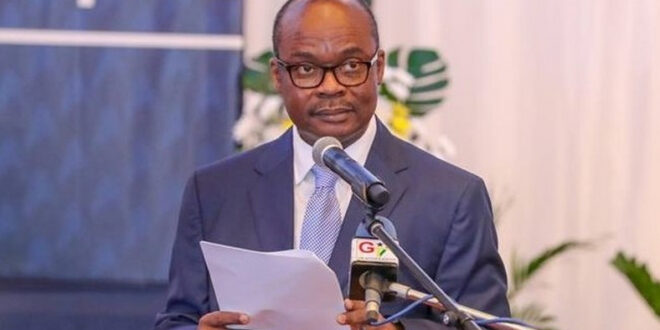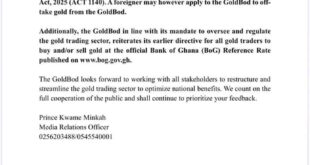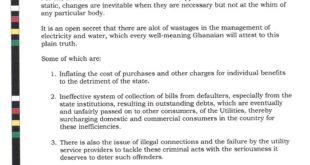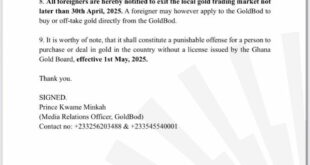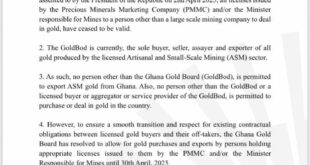The Monetary Policy Rate of the Bank of Ghana has increased its policy rate – the rate at which it lends to commercial banks – by 100 basis points to 28%.
Within a year, the rate has gone up by a staggering 13.5%
The Central Bank cited downside risks to inflation and exchange rate depreciation as the major reason. These risks have been driven by fiscal imbalances.
“In the interim, the MPC [Monetary Policy Committee] sees the need to remain vigilant and moderate liquidity in the system to underpin macroeconomic adjustments taking place to drive inflation on a
downward path. Under the circumstances, the Committee decided to increase the policy rate by 100 basis points to 28%”, the MPC chaired by the Governor of the Bank of Ghana, Dr. Ernest Addison revealed.
The Governor also said underlying inflationary pressures similarly remained elevated as the Bank’s core inflation measure, which excludes energy and utility, accelerated to 53.2% in December 2022, from 49.7% in November.
“However, the Bank’s surveys on consumers, businesses, and the financial sector showed that inflation expectations eased in December 2022. This indicates agents’ expectations of moderation in inflationary pressures on the horizon”, he mentioned
The upward adjustment in the policy rate means cost of loans will go up further, and will consequently worsen the cost of doing business in the country.
Already, average lending rates have shot up significantly to 35.58% in December 2022, from 33.87% recorded in November 2022.
This is equivalent to 2.82% interest rate on loans per month.
According to the January 2023 Summary of Economic and Financial Data, average lending rates have been increasing sharply since a year ago.
In actual fact, it has gone up by 15.42% since January 2022.
Read the full statement below:
Good morning, Ladies and Gentlemen of the Media.
The Monetary Policy Committee, last week, held its 110th meeting, the first for the year 2023. The Committee deliberated on recent global economic developments and how they contributed to shaping Ghana’s macroeconomic conditions in 2022 and assessed risks to the outlook for inflation and growth.
The Committee also took note of progress under the Government of Ghana’s Domestic Debt Exchange Programme launched in December 2022 in the context of ongoing negotiations with the International Monetary Fund (IMF) for financial support.
Below is a summary of the assessment for 2022, the outlook for 2023 and the mediumterm, and the key issues that informed the Committee’s decision on the stance of monetary policy:
1. The global economy came under severe strain in 2022 on the back of continued spillovers from geopolitical tensions, continued tightening of monetary policy across countries, even as policy uncertainty heightened amidst fears of recession in advanced economies. The latest Purchasing Managers’ Indices (PMI) pointed to broad-based slowdown in economic activity at the end of 2022, especially across Advanced Economies. In Emerging Market and Developing Economies (EMDEs), growth conditions weakened on account of tightened global financing conditions, dampened external demand, and moderated consumer spending as inflation rose.
The latest IMF projections show that global growth will further moderate from the projected 3.2 per cent in 2022 to 2.7 per cent in 2023, reflecting mainly growth decline in Advanced Economies.
2. In the last quarter of 2022, headline inflation started showing signs of easing in some advanced and emerging market economies, supported by declining commodity prices and weaker demand. This notwithstanding, there are underlying inflation pressures from the pass-through effects of past input costs, rising wages especially in Advanced Economies, currency depreciation against the U.S. dollar, and rising short-term inflation expectations which remain major concerns for central banks.
3. Global financing conditions tightened considerably on account of the aggressive policy stance in Advanced Economies to contain inflation, despite some moderation in rate hikes by the U.S. Federal Reserve Bank in the last quarter of 2022. The European Central Bank, Bank of England, and other central banks across Advanced Economies, have also signalled intentions to maintain a tight policy stance to control inflation.
Equity markets recovered somewhat amid the expectation that inflation had peaked and central banks might slow the pace of policy rate hikes. Longer term bond yields declined, while the U.S. dollar lost some ground against major currencies.
4. On the domestic front, inflation remained elevated in 2022, driven by both demand pressures and supply shocks. The two price readings since the last MPC meeting showed a significant jump in headline inflation to 54.1 percent in December 2022, from 50.3 percent in November and 40.4 percent in October 2022. The acceleration in inflation was driven mainly by the lagged effects of the sharp currency depreciation recorded in October. Food and non-food inflation went up significantly.
Food inflation surged to 59.7 percent in December from 55.3 percent in November 2022, while nonfood inflation rose to 49.9 percent from 46.5 percent over the same comparative period.
5. Underlying inflationary pressures similarly remained elevated. The Bank’s core inflation measure, which excludes energy and utility, accelerated to 53.2 percent in December 2022 from 49.7 percent in November. However, the Bank’s surveys on consumers, businesses, and the financial sector showed that inflation expectations eased in December 2022. This indicates agents’ expectations of moderation in inflationary pressures on the horizon.
6. Economic activity for the first three quarters of 2022 was within projections, albeit at a moderated pace than a year earlier. The latest data from the Ghana Statistical Service showed that real GDP expanded at an annual rate of 3.6 percent during the first three quarters of 2022 relative to 4.8 percent during the corresponding period in 2021. Non-oil GDP growth also moderated to 4.3 percent from 4.7 percent over the same comparative period. The observed growth outturn was driven by the services and agriculture sectors.
7. Further into the fourth quarter, the Bank’s high frequency indicators recorded a moderation in economic activity. The updated Composite Index of Economic Activity (CIEA) contracted by 6.2 percent in November 2022, compared with a growth of 10.2 percent in the same period of 2021. The major items that weighed down the Index during the period were port activity, cement sales, imports, and industrial consumption of electricity.
8. The latest confidence surveys conducted by the Bank in December 2022 pointed to some marginal improvement in sentiments. Consumer confidence improved on the back of the recent reductions in ex-pump petroleum prices and transportation fares.
Business sentiments also turned positive due to achievement of short-term targets and optimism about company and industry prospects, following the rebound of the local currency during the month. The survey findings were broadly aligned with observed trends in Ghana’s PMI, which improved to 47.0 percent in December 2022 from 44.9 percent in the previous month.
9. Broad money supply, including foreign currency deposits (M2+), grew by 33.0 percent in year-on-year terms, in December 2022, relative to 12.5 percent in December 2021. The growth in M2+ was driven mainly by significant expansion in the Net Domestic Assets of the depository corporations’ sector, moderated by a decline in Net Foreign Assets (NFA). Reserve money recorded an annual growth of 57.5 percent relative to 19.9 percent, over the same comparative period.
10. Similarly, private sector credit growth picked up, partly reflecting continued portfolio rebalancing by banks and revaluation effects on foreign currency denominated credit.
In nominal terms, private sector credit increased by 31.8 percent in December 2022, compared with 11.2 percent in December 2021. In real terms, however, private sector credit contracted sharply by 14.5 percent, compared with 1.3 percent contraction over the review period, reflecting sustained price pressures.
11.Developments in the banking sector were broadly reflective of current macroeconomic conditions, with rising cost of credit due to inflationary pressures, and revaluation-driven balance sheet performance. As a result, the performance of the sector moderated in December 2022 compared with December 2021, with some key Financial Soundness Indicators (FSIs) recording significant declines.
12. Profitability levels in the banking sector have declined, driven by the mark-to-market losses on investments, higher impairments on loans, and rising operating costs.
Profit-after-tax was GH¢3.9 billion at end December 2022, representing 18.9 percent contraction year-on-year, compared to 12.3 percent annual growth recorded in 2021.
Net interest income grew by 23.0 percent to GH¢15.8 billion, higher than the growth of 14.5 percent in 2021. Net fees and commissions went up by 27.4 percent to GH¢3.7 billion, from the growth of 24.8 percent recorded in 2021. Accordingly, operating income increased by 30.9 percent, compared with 14.6 percent recorded a year earlier. The strong outturn in operating income was however moderated by increased operating expenses and provisioning during the year. Operating expenses rose by 32.2 percent in December 2022, compared with 14.2 percent growth in 2021.
Provisions also increased sharply by 184.0 percent in December 2022 relative to a contraction of 4.7 percent a year earlier, due to the strong uptick in credit growth, elevated credit risks, and impairments on investments. As a result, profit before tax declined by 13.5 percent to GH¢6.4 billion in December 2022, compared with an annual growth of 22.1 percent a year earlier. New loans and advances in 2022 increased to GH¢53.7 billion, reflecting an annual growth of 47.5 percent, compared with the growth of 6.8 percent in 2021.
13.Trends in Financial Soundness Indicators were mixed, reflecting heightened risks faced by the industry. The industry’s Capital Adequacy Ratio (CAR) declined to 16.6 percent, but remained above the prudential minimum of 13 percent, as at December 2022, from 19.6 percent in December 2021, attributed to losses on mark-to-market investments, increase in risk-weighted assets of banks from the high growth in actual credit, and the price effect of the depreciation of the Ghana Cedi on foreign currency denominated loans. The sector’s profitability indicators, namely, the return-on-equity and the return-on-assets also declined during the period, in line with declining profit after tax and profit-before-tax, respectively. The non-performing loans (NPL) ratio however improved to 14.8 percent in December 2022 compared with 15.2 percent in December 2021, on account of high credit growth, relative to the increased stock of NPLs between the two periods.
14.Total assets increased to GH¢221.0 billion, representing an annual growth of 22.9 percent in December 2022, compared to a growth of 20.4 percent a year earlier. Total deposits ended the year at GH¢157.9 billion, representing an increase of 30.4 percent in 2022, relative to a growth of 16.6 percent in 2021. Credit continued to increase, recording a growth of 30.2 percent to GH¢70.0 billion from GH¢53.8 billion in December 2021. Total investments, on the other hand, contracted by 4.8 percent to GH¢79.2 billion in December 2022, relative to a 29.0 percent annual growth in 2021, as banks rebalanced asset portfolios in response to the Domestic Debt Exchange Programme.
15.Provisional data on budget execution for the period January to November 2022 indicated an overall broad fiscal deficit (cash) of 9.8 percent of GDP, against the programmed target of 6.7 percent of GDP. The corresponding primary balance for the period was a deficit of GH¢18.8 billion (3.1 percent of GDP), against a deficit target of GH¢3.1 billion (0.5 percent of GDP). Over the review period, total revenue and grants was GH¢81.8 billion (13.3 percent of GDP), short of the projected target of GH¢84.0 billion (13.6 percent of GDP). Total expenditure of GH¢142.2 billion (23.1 percent of GDP) was above the programmed target of GH¢125.4 billion (20.4 percent of GDP). The deficit of GH¢60.4 billion was financed mainly from the domestic sector.
16. The external sector performance in 2022 was shaped by developments in the global economy. There was a significant improvement in the merchandise trade account, which helped to narrow the current account deficit to 2.3 percent of GDP from 3.2 percent in 2021. These gains were however negated by huge net outflows in the capital and financial account, due mainly to external factors which caused portfolio reversals and reduced foreign direct investments, resulting in an overall balance of payments deficit and loss of reserves.
17. Ghana’s key export commodities prices remained volatile on the global markets. Average crude oil prices, on year-on-year terms, increased by 81.3 percent, rising from US$85.5 per barrel in January 2022 to a high of US$117.2 per barrel in June on supply concerns, before retreating to US$81.3 per barrel in December on the back of reduced demand amid recession fears. Cocoa futures traded largely in the negative during most parts of 2022. Prices peaked at US$2,681.11 per tonne in February, on the back of lower production volumes, and thereafter eased to a low of US$2,333.33 per tonne in July 2022 owing to weak grind data. At the end of 2022, cocoa prices rose to US$2,538.6 per tonne, representing 2.3 percent year-on-year growth. Gold prices hit record levels of US$1,949.4 per ounce in March, benefiting from heightened global uncertainties, but weakened later due to interest rate hikes and a stronger US dollar to end the year at US$1,796.2 per ounce, representing 8.7 percent annual growth.
18.The trade surplus more than doubled to US$2.8 billion in the 2022 compared with US$1.1 billion in 2021. This was driven by higher exports growth, relative to the growth in imports. Total exports increased by 18.2 percent year-on-year to US$17.4 billion, driven by crude oil, gold and other exports earnings. This compares with US$14.7 billion export earnings recorded in 2021. In detail, crude oil export earnings reached US$5.4 billion, driven by sharp increases in prices, from US$3.9 billion in 2021, representing an increase of 37.5 percent in year-on-year terms. Gold exports also rose by 30.0 percent to US$6.6 billion, on the back of increased volumes from small-scale gold production. Cocoa exports, however, declined to US$2.2 billion from US$2.8 billion, reflecting both price and volume reductions. Other export earnings, including non-traditional exports, reached US$3.2 billion, an increase of 10.2 percent.
19.The total import bill increased by 7.0 percent to US$14.65 billion in 2022, due to higher payments for oil and gas imports. Of the total import bill, oil and gas, mainly refined petroleum imports, amounted to US$4.7 billion driven by higher prices, compared to US$2.7 billion in 2021, representing 71.3 percent annual growth. On the other hand, the sharp exchange rate depreciation led to non-oil imports compression of 8.4 percent to US$10.0 billion, reflected mainly in consumption and capital goods imports.
20.The improved trade surplus together with a higher remittances’ inflow, helped to narrow the current account deficit to US$1.64 billion from US$2.5 billion in 2021, despite higher payments recorded in the services and income accounts. The capital and financial accounts recorded a net outflow of US$2.2 billion compared with a net inflow of US$3.3 billion recorded in 2021. The current account deficit, together with the net Capital and Financial account outflow, resulted in an overall balance of payments deficit of US$3.6 billion in 2022, compared to a surplus of US$510.1 million in 2021.
21.At the end of December 2022, the stock of Gross International Reserves stood at US$6.2 billion (equivalent to 2.7 months of import cover) from a stock position of US$9.7 billion (equivalent to 4.4 months of import cover) at the end of December 2021. The Net International Reserve position stood at US$2.4 billion, from US$6.1 billion over the same comparative period.
22.The local currency came under intense pressure in the year, reflecting the portfolio reversals and lower foreign direct investment inflows, while demand pressures increased. For the year 2022, the Ghana cedi depreciated by 30.0 percent against the US dollar, after reversals of some of the losses in December. This compares with 4.1 percent depreciation in 2021. In the year to January 26, 2023, the Ghana cedi cumulatively depreciated by 19.1 percent, 21.4 percent, and 20.7 percent against the US dollar, the Pound, and Euro, respectively. In comparison with the same period of last year, the Ghana Cedi had depreciated by 1.5 percent against the US dollar and appreciated by 0.1 and 0.7 percent against the Pound and Euro, respectively.
Summary and Outlook
23.The global economic outlook remains uncertain owing to broad-based and elevated inflation, policy tightening, worsening financing conditions, and lingering spillover effects of geopolitical tensions. These headwinds are likely to persist through the first half of 2023, driving down confidence and weakening real household disposable incomes in advanced and emerging market economies. The ongoing geopolitical tensions continue to weigh on economic and policy uncertainty, especially in the Euro Area. For emerging and developing economies, growth momentum is projected to remain firm, supported by the relaxation of lockdown restrictions in China and still high commodity prices. Though showing signs of cooling, inflation levels remain elevated, and central banks, especially in advanced economies, have signalled the need to maintain the tight monetary policy stance to contain inflationary pressures, albeit, at a measured pace.
24.Domestic growth conditions softened in 2022 and is projected to moderate further and remain below potential over the near-term, based on the elevated inflation levels.
The updated CIEA showed continued dip in economic activity, despite the slight improvement in consumer and business sentiments from the latest surveys. In nominal terms, credit to the private sector rose sharply, but was moderated in real terms by price pressures.
25.There are emerging signs that the current macroeconomic conditions are spilling over to the banking sector. Profitability levels have declined alongside other financial soundness indicators. The latest macro-prudential risk assessments indicated increased pressure on solvency and liquidity of banks ahead of the implementation of the Domestic Debt Exchange Programme. To moderate the potential impact on the sector, the Bank of Ghana has announced some regulatory reliefs for banks to help preserve financial stability.
26.The Government of Ghana has reached a Staff Level Agreement (SLA) with the IMF which spells out measures that will put the fiscal on the path of consolidation.
Consistent with the SLA was the 2023 Budget which has just been passed by parliament and frontloads the consolidation efforts. Revenue enhanced measures such as the VAT increase of 2.5 percent, the complete removal of benchmark values on imports, and the review of the E-Levy should help improve the revenue outlook.
On the expenditure side, the lower capping on transfers to earmarked funds from 25 to 17.5 percent, and the reduction of budgetary allocation to goods and services, as well as rationalisation of executive compensation should help contain expenditures in 2023. The concerns being expressed in the public domain relating to high government expenditures have been addressed in the SLA and reflected in the 2023 Budget.
27.The SLA is also contingent on the Domestic Debt Exchange Programme and external debt restructuring, which when concluded and the necessary financial commitment obtained, will allow the presentation of the SLA to the IMF Board. The MPC believes that these measures will help restore fiscal and debt sustainability and bring down inflation as well as help stabilise the currency.
28.In the interim, the MPC sees the need to remain vigilant and moderate liquidity in the system to underpin macroeconomic adjustments taking place to drive inflation on a downward path. Under the circumstances, the Committee decided to increase the policy rate by 100 basis points to 28 percent.
Thanks for reading from MyGhanaMedia.com as a news publishing website from Ghana.
Source: MyGhanaMedia.com
 MYGHANAMEDIA.COM Best Source Of Latest News
MYGHANAMEDIA.COM Best Source Of Latest News
